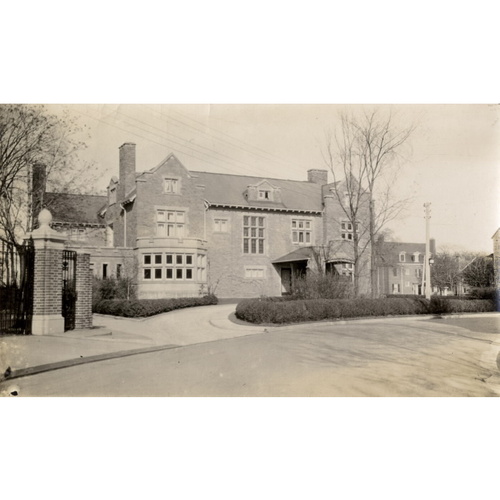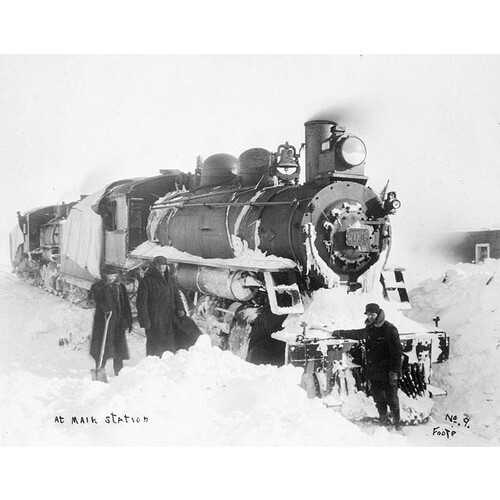Hanna, David Blythe, accountant, railway manager and president, and office holder; b. 20 Dec. 1858 in Thornliebank (Glasgow), Scotland, second youngest of the ten children of William Hanna, a foreman in a textile-printing mill, and Janet Blair; m. 3 April 1889 Margaret L. Garland in Portage la Prairie, Man., and they had one son and two daughters; d. 1 Dec. 1938 in Toronto.
Educated in Thornliebank and Glasgow, David Blythe Hanna began his railway career at age 13 as a junior clerk on the Glasgow, Barrhead and Kilmarnock Joint Railway. In 1875 he moved to the Caledonian Railway and he continued in its service until 1882. That year he emigrated to Canada after answering the Grand Trunk Railway’s advertisement for clerks. He worked for two years in Montreal in the auditor’s office of the GTR and spent a short time in Detroit on the railway’s behalf, auditing the books of the New York, West Shore and Buffalo Railroad. He then joined the American company in its New York office. When, in 1886, the organization became part of the New York Central Railroad system, he accepted an appointment in Portage la Prairie as chief accountant (later treasurer) of the Manitoba and North Western Railway, whose directors had ambitions to build an extensive network of lines in northwestern Manitoba and beyond. Financing proved difficult to obtain, however, and the Manitoba and North Western went into receivership in 1893. Hanna moved to Winnipeg and continued with the railway while auditing accounts for other firms.
In 1896 Hanna left the Manitoba and North Western to become superintendent, or general manager, of the Lake Manitoba Railway and Canal Company, a small colonization railway being promoted and built by William Mackenzie* and Donald Mann. In December 1898 the LMRC was amalgamated with another small line, the Winnipeg Great Northern, to form the Canadian Northern Railway. Since federal regulations prevented Mackenzie and Mann, as contractors, from holding office as directors, Frederic Thomas Nicholls* became president. Hanna continued as superintendent. The acquisition of several other local railway charters in southeastern Manitoba and southwestern Ontario enabled the Canadian Northern to connect its prairie lines with port facilities on the Great Lakes at Port Arthur (Thunder Bay), Ont., in 1901.
One of the railway’s four most influential directors, Hanna would serve in a managerial capacity for 20 years. After Mackenzie and Mann incorporated their construction firm in 1902, they were free to become directors of the railway. Mackenzie, as president, looked after the financing, while Mann, first vice-president, supervised much of the construction. Hanna, third vice-president, was the railway’s chief operating officer, and chief solicitor Zebulon Aiton Lash*, the fourth member of the talented quartet, handled the railway’s extensive and often complicated legal affairs. Hanna’s designation as third vice-president was somewhat unusual because he exercised more power than the second vice-president, who was Roderick John Mackenzie, William’s eldest son. Roderick John worked as one of the contractors, but he never assumed his executive position and did not acquire the influence of Hanna or Lash.
The Canadian Northern Railway had expanded rapidly after 1901. An extensive network was built on the prairies, mostly north of the Canadian Pacific Railway’s main track. The initial construction was financed largely through the issue and sale of bonds and debentures guaranteed by provincial and federal governments, and costs were kept as low as possible. Rolling stock discarded by more prosperous railways was refurbished and placed in service on branch lines. Thus, breakdowns, derailments, and other unexpected disruptions frequently challenged Hanna’s managerial abilities and ingenuity, as did the need to minimize costs and freight rates. Yet the ways in which he discharged his responsibilities earned the railway a reputation as “the Farmers’ Friend.” Since it carried their freight at reasonable prices, farmers were willing to forgive the railway its erratic service.
Hanna was not aware of a grand master plan guiding the early development of the Canadian Northern, or of a moment when Mackenzie and Mann first thought of building a transcontinental railway. Nor was he intimately involved in the formulation of their response to the 1902 decision of the Grand Trunk [see Charles Melville Hays*] to build a railway to the Pacific. However, he played a significant role in constructing the Canadian Northern’s branch lines and in determining the policies that would severely restrict the capacity of the rival Grand Trunk Pacific to gather traffic on the prairies. His efforts helped ensure that the rival company would be placed in receivership in 1919.
Hanna fully supported the Canadian Northern Railway’s expansion westward to the Pacific and, after 1911, eastward to the Atlantic. Later he emphatically rejected allegations that the financial difficulties the Canadian Northern would soon experience were attributable to high construction and operating expenses and to sparse local traffic on the British Columbia and Ontario–Quebec lines. He blamed the escalating costs of material, labour, and equipment during World War I and the difficulties of raising needed funds on world money markets during the conflict.
In 1917 the federal government purchased the Canadian Northern Railway but retained Hanna’s services, naming him chairman of its new board of directors in September 1918. In November the line’s operations were merged with those of the National Transcontinental and the Intercolonial under what would soon be designated as the Canadian National Railways. Hanna, with his proven managerial and financial skills, was appointed the CNR’s first president. The integration of the component lines, each with its distinctive operational, political, and financial structures, proved difficult. For Hanna, traditions of political meddling and patronage on the old Intercolonial were particularly frustrating. At one point he declared that even the archangel Gabriel could not have satisfied Maritimers if he had had the task of combining their inefficient and money-losing railway with the new national system.
The appointment of Hanna to the presidency would prove to be only an interim measure. The federal government also wrestled with the problems of the Grand Trunk and Grand Trunk Pacific railways; by 1922 the decision had been made to nationalize the entire Grand Trunk Railway system and make it part of the CNR. It seemed impractical to ask Grand Trunk managers to work harmoniously under a president closely linked to their rival. Hanna had, to some extent, been identified with the Conservative Party, a fact which may have influenced the decision of William Lyon Mackenzie King*’s recently elected Liberal government to ask Hanna and his fellow directors to resign their positions; however, even some Conservatives had recognized the CNR’s need for leadership unconnected with the former lines. In July 1922 Hanna’s long railway career ended.
In addition to having served on railways and as an officer or director of numerous companies connected with Mackenzie and Mann, Hanna also held positions on the boards of other firms, including the Manufacturers Life Insurance Company, the London and Canadian Loan and Agency Company, the Western Assurance Company, Western Canada Flour Mills, and the British Empire Trust Company. In 1927 he was persuaded to come out of retirement to act as the first chairman of the Liquor Control Board of Ontario. He left the following year, after the organizational work was completed. In the autumn of 1938 he was not in good health and, according to his son, the death on 30 November of his oldest friend, banker Sir John Aird, “was a tremendous shock to him.” Hanna died the next day.
Blessed with a strong bass voice, Hanna was passionate about music and was noted for his wit and humour, but he was, first and foremost, a railway man who proudly described himself as “Exhibit A of the Canadian Northern Railway.” His memoirs, published in 1924 as Trains of recollection drawn from fifty years of railway service in Scotland and Canada and written with the help of Arthur Hawkes, had first appeared in the pages of the Toronto Daily Star. The town of Hanna, Alta, perpetuates his memory.
David Blythe Hanna is the author of Trains of recollection drawn from fifty years of railway service in Scotland and Canada, ed. Arthur Hawkes (Toronto, 1924).
Man., Dept. of Tourism, Culture, Heritage, Sport and Consumer Protection, Vital statistics agency (Winnipeg), no.1889-001005. Globe and Mail, 2 Dec. 1938. T. D. Regehr, The Canadian Northern Railway, pioneer road of the northern prairies, 1895–1918 (Toronto, 1976). A statutory history of the steam and electric railways of Canada, 1836–1937, with other data relevant to operation of Department of Transport, comp. Robert Dorman (Ottawa, 1938). G. R. Stevens, Canadian National Railways (2v., Toronto and Vancouver, 1960–62), 2.
Cite This Article
T. D. Regehr, “HANNA, DAVID BLYTHE,” in Dictionary of Canadian Biography, vol. 16, University of Toronto/Université Laval, 2003–, accessed December 31, 2025, https://www.biographi.ca/en/bio/hanna_david_blythe_16E.html.
The citation above shows the format for footnotes and endnotes according to the Chicago manual of style (16th edition). Information to be used in other citation formats:
| Permalink: | https://www.biographi.ca/en/bio/hanna_david_blythe_16E.html |
| Author of Article: | T. D. Regehr |
| Title of Article: | HANNA, DAVID BLYTHE |
| Publication Name: | Dictionary of Canadian Biography, vol. 16 |
| Publisher: | University of Toronto/Université Laval |
| Year of publication: | 2014 |
| Year of revision: | 2014 |
| Access Date: | December 31, 2025 |


![[Canadian Northern Railway locomotive No. 2036 at Mair station Sask.]. Original title: [Canadian Northern Railway locomotive No. 2036 at Mair station Sask.].](/bioimages/w600.2615.jpg)


